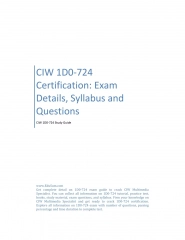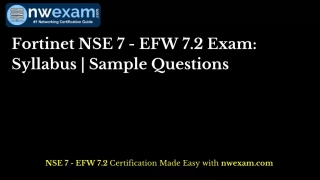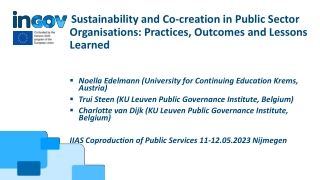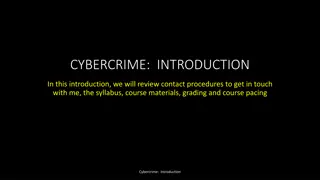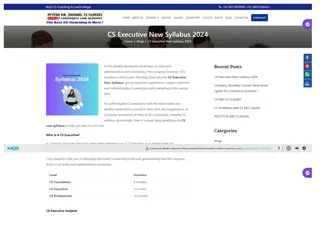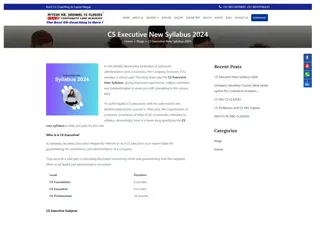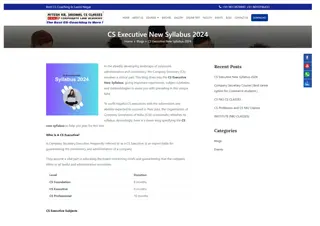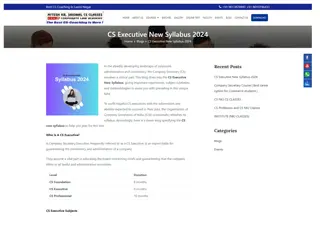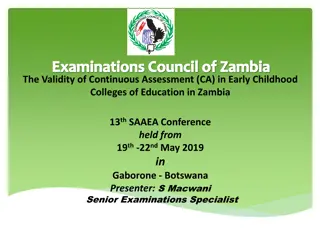
Mediating Student Success Through Shared Governance in Syllabus Design
Explore the effective role of shared governance in mediating student success through syllabus co-creation. Learn how involving students in designing course policies enhances understanding, cooperation, and trust. Real-life examples and practical tips are provided for syllabus co-creation.
Download Presentation

Please find below an Image/Link to download the presentation.
The content on the website is provided AS IS for your information and personal use only. It may not be sold, licensed, or shared on other websites without obtaining consent from the author. If you encounter any issues during the download, it is possible that the publisher has removed the file from their server.
You are allowed to download the files provided on this website for personal or commercial use, subject to the condition that they are used lawfully. All files are the property of their respective owners.
The content on the website is provided AS IS for your information and personal use only. It may not be sold, licensed, or shared on other websites without obtaining consent from the author.
E N D
Presentation Transcript
Mediating the Syllabus: Student Success Through Shared Governance Madelyn Fox-Defago, Ph.D. Lecturer, English Dept.
Why Wont They Read the Syllabus? Because many don t understand what a syllabus actually is.
What Do They Think a Syllabus Is? Just a formality arbitrary information from KSU A set of requirements and barriers to getting the grade they want Rules their professor designed to catch students when they mess up Which therefore doesn t apply to them because they re a good student a syllabus is just there to catch the bad students
What We Want Them to Understand A syllabus is a framework and guide for how to be successful in this course. It s written for them, not for us. It applies to and has valuable information for all students.
Mediating Through Shared Governance Have students help design course policies to empower and engage them, while also demonstrating the role of a syllabus. 1. They will know and, more importantly, understand the policies because they re helping write and revise them. 2. They are given the power to push back on and negotiate any policies they feel are unfair, fostering cooperation and trust.
Real-Life Examples Communication policy reasonable response time Late work policy minor assignments Deadlines Friday work for 33% hybrid course
Syllabus Co-Creation Don t: Don t agree to any policies you re not comfortable enforcing or that don t align with your teaching philosophy Don t sacrifice academic rigor Don t feel like you have to hand over your entire course design you get to pick and choose which items are up for negotiation Do: Think about which aspects of your course are negotiable, and to what extent Set boundaries when needed Encourage debate and conversation about the why behind specific policies from both perspectives
Step 1: Syllabus Inventory Identify which of your current policies are hard or soft Hard policies are set in stone and not open to negotiation Soft policies have room for negotiation how much room is up to you
Hard Policies Examples: Required materials, program objectives, major assignment genres, etc. You must provide a rationale not only for the policy itself, but for why it s non-negotiable, based on your expertise, research in learning science, and/or student success initiatives. If you re having trouble identifying a rationale, consider moving it to the soft policy list.
Soft Policies Examples: Attendance, late work and deadlines, technology use, etc. You ll need to identify the baseline expectations for students that you have or need to maintain Again, these should be based on research in learning science and/or your expertise as an instructor, and you should provide that rationale to students.
Step 2: Implementation To do this effectively will require devoting more time to syllabus days than you normally would. You ll need ample time for students to propose, discuss, revise, and finalize the policies, but You can figure out creative ways to do this that also help you cover content/course objectives, and The payoff in improved engagement and student-teacher interactions is worth the investment.
Facilitating Negotiations Provide examples of your own past policies and/or examples from other instructors and have them voice questions/disagreements Identify and list basic parameters that policies should cover I.e., what happens if someone is late; whether it matters how late they are; whether there is any penalty for a certain number of absences, or just the natural consequence of missing in-class grades; what someone should do if they miss class or are late; etc. Outline instructor responsibilities vs. student responsibilities
Considerations How many days do you want to spend on this? How much will take place synchronously vs. asynchronously? Small groups? Whole-class discussion? Both? (F2F or online) How to negotiate conflicting instructor-student expectations? Any forum for anonymous comments/suggestions? How will the class ultimately finalize the policies? Follow-up for any dissent/concerns?
One Example First Meeting Second Meeting Introduce and explain the general process for co-creating the policies and your rationale for doing so. Explain the purpose of a syllabus and emphasize students role and agency in designing these policies. Students assignment for the next class is to draft their proposed syllabus policies. First Half: Students meet in small groups to discuss and condense their individual proposed policies. You remind them of parameters/ expectations to help guide them. Second Half: The class condenses all of these into one rough draft.
One Example Asynchronous Assignment Third Meeting Students are given commenting permission on the draft and are asked to make comments with revisions/questions before the next class meeting. You are also actively involved in the document, making comments where necessary to align policies with your teaching practices and philosophy. First Half: Final discussion and negotiation. Second Half: Students vote on whether to approve the policies wholesale, with a 2/3 majority needed. Provide a clear way for students who dissented to voice their questions/concerns.

